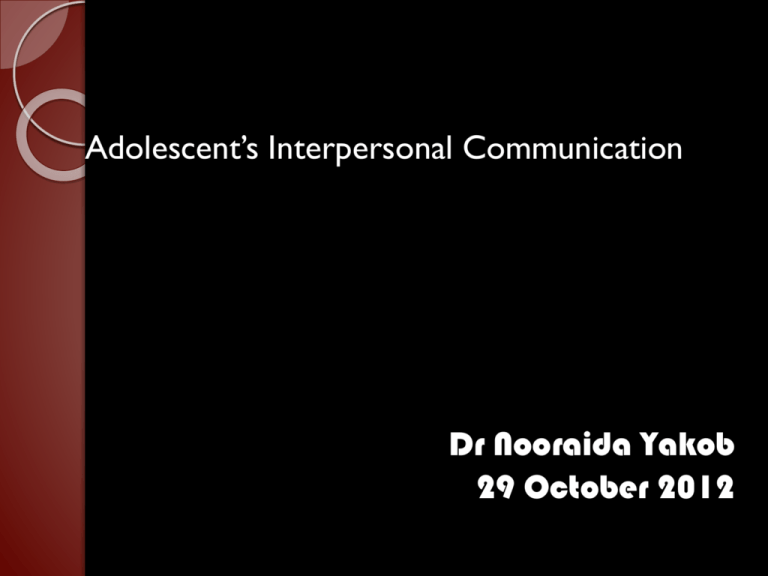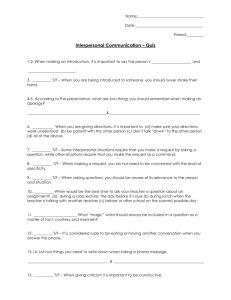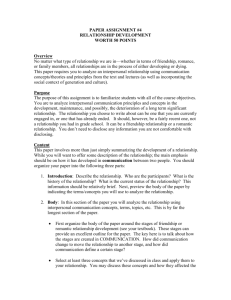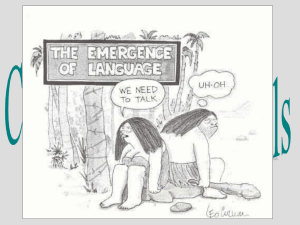Komunikasi Intrapersonal
advertisement

Adolescent’s Interpersonal Communication Dr Nooraida Yakob 29 October 2012 DEFINITION Communication - the process of responding to the information Human’s communication – a process of communication in order to share feelings / information with others through the use of verbal and non verbal language Interpersonal communication - a specific form of human’s communication in handling relationships with other people Interpersonal communication occur spontaneously, transparent, nonjudgmental and based on the similarities between individuals with other individuals. Example : if you are from the same place, the communication becomes more personal and the quality of your communication become more intimate Based Bebee (2005) There are two views: ◦ Contextual view The number of people involved Have affinity/similarities between them Feedback are given and often is immediate Developmental View According to this view, communication occurs when: ◦ Individuals involved have been known for a long time ◦ Each individual is unique ◦ Example : Communication between a salesman is not the same as communication between friends or family According to Martin Buber (2005) Divided into three types of communication: ◦ Communication "I-It" Communication in our social life Usually exists between you and salesman, you and waitress Usually, the relationship begins with this type of communication. The closer the relationship is will lead to you the second stage of "I-You" According to Martin Buber (2005) Communication "I-You" Most of our communication is “I-YOU” Interactions that exist still weighed on the social role Example : teacher-student relationship The relationship exists is still not close - Example : ordinary partnership, coworkers and you-cousins. According to Martin Buber (2005) Communication "I-Thou" High-level of communication The communication exists is beyond the social role and often affect the uniqueness of the individual Communication involves : trust and personal matters lead to a close relationship Example : communication of lovers, parents and children, siblings, close friends Communication "I-Thou" There are individuals who never achieve this communication There are several ways to achieve this type of communication: ◦ Be a good listener ◦ Build a close relationship ◦ Resolve and avoid conflicts effectively ◦ The success of developing this type of communication gives the individuals a satisfaction in life The Importance of Interpersonal Communication 1. 2. 3. 4. Improving your communication skills with family members Build a close relationship with friends and the one who you loved Improved your relationship with your colleagues Increased your physical and emotional health The Importance of Interpersonal Communication Request the information ◦ Based on the Social Penetration Theory – with the information, the interaction between individuals will be more effective ◦ As a result : you can expect what your friend’s thinks, do and felt ◦ You can get the information in a passive way by observation ◦ You can get information by actively engage in communication ◦ Self-disclosure The Importance of Interpersonal Communication Build a context of understanding ◦ help us better understand what someone says in a given context ◦ depending on how they are said or in what context ◦ Two types: Content message - surface level meaning of a message" Relationship message – explained how the message was said These two are sent simultaneously, but each affects the meaning assigned to the communication. The Importance of Interpersonal Communication Establish your identity ◦ The roles we play in our relationships help us to establish identity ◦ the public self-image we present to others Interpersonal needs ◦ Express and receive interpersonal needs ◦ The needs are : Participation, control and affection The needs …. Inclusion ◦ is the need to establish identity with others. Control ◦ is the need to exercise leadership and prove one's abilities. Groups provide outlets for this need. Some individuals do not want to be a leader. For them, groups provide the necessary control over aspects of their lives. Affection ◦ is the need to develop relationships with people. Groups are an excellent way to make friends and establish relationships. Forms of Interpersonal Communication Oral Communication ◦ Verbal Expression language - speech Receptive language – understanding/comprehending Non-verbal communication ◦ Use facial expressions - eye-contact, your drawing, writing, body movement, etc. The Development of Self-concept 1. Interaction with other individual - see yourself through the mirror 2. Joined yourself in the group 3. Expected role 4. Label yourself - The label comes from personal reflection 5. Personality The development of Self-Esteem ◦ assessment of self-perceptions on the ability, talent, skills and appearance How to Increasing your self-esteem Intrapersonal Communication Your positive self-image Avoid comparing yourself with others Limit the events and experiences to the broader aspects Ability to focus on your vision Get support from an appropriate individuals Self-disclosure The strategy used to share the information with others With a view, the relationship becomes more intimate/close By using “Johari window” Used to better understanding of their mental instability ◦ http://kevan.org/johari Johari Window (Joseph Luft & Harry Ingham, 1950’s Not Known to self Not Known to Others Known to Others Known to self OPEN BLIND HIDDEN UNKNOWN A Johari window consists of the following 56 adjectives used as possible descript In alphabetical order they are: •intelligent •able •dependable •introverted •accepting •dignified •kind •adaptable •energetic •Knowledge •bold •extroverted able •brave •friendly •logical •calm •giving •loving •caring •happy •mature •cheerful •helpful •modest •clever •idealistic •nervous •complex •independent •observant •confident •ingenious •organized •patient •powerful •proud •quiet •reflective •relaxed •religious •responsive •searching •selfassertive •selfconscious •sensible •sentimental •shy •silly •smart •spontaneous •sympathetic •tense •trustworthy •warm •wise •witty Open: Adjectives that are selected by both the participant and his or her peers are placed into the Open quadrant. This quadrant represents traits of the subjects that both they and their peers are aware of. Hidden: Adjectives selected only by subjects, but not by any of their peers, are placed into the Hidden Quadrant, representing information about them their peers are unaware of. It is then up to the subject to disclose this information or not. Blind Spot: Adjectives that are not selected by subjects but only by their peers are placed into the Blind Spot quadrant. These represent information that the subject is not aware of, but others are, and they can decide whether and how to inform the individual about these "blind spots". Unknown: Adjectives that were not selected by either subjects or their peers remain in the Unknown quadrant, representing the participant's behaviors or motives that were not recognized by anyone participating. This may be because they do not apply or because there is collective ignorance of the existence of these traits. 1. Open Area Other people know about you.You also know about yourself. The more you know about yourself or other people know about you, the greater the open space this section Example : your attitudes, feelings, emotions, knowledge, experience, skills and insights 2. Blind Area Others know about you, but you did not know This section is realized by you and you unconsciously communicate it to others Information may be in the form of body language, behavior, voice, style When you learn and begin to realize about yourself, this section begins to diminish 3. Hidden Area You know about you but other people did not know about you Information including feelings, opinions, prejudices, and experience You think about the facts, thoughts, feelings, fantasies that you do not want others to know due to your nature (shyness) Keeping it as secrets 4. Unknown Area This section is not known by you and others There are things you did not already know about yourself Example “ ◦ How to act when faced with the death of someone that you loved . Other people do not know Example : talents / abilities that you have Everybody has this area The characteristic of self-disclosure Occurred gradually Occurred from the less personal information to more personal Have certain risk Related to trust and honest Potential to improve the quality of interpersonal relationships Relationship Development Knapp’s Relationship Escalation Model ◦ There are five stages: Initiatian - short stage :-10-15 seconds. Eg. Greeting Experimenting - you ask questions to obtain more information and make a decision whether to continue the relationship or not Intensifying - self-disclosure occurred, the relationship becomes more informal and are committed to that relationship Continued .... Integrating - becomes close, work together, and start to share the identity with partners Bonding – you have the relationship however only few of relationship ended at this level. The Termination of Relationship Knapp’s Relationship Termination Model There are five stages: ◦ Differentiating you start to use the word "I" instead of "we" Beginnings of self-reliance/autonomy Early signs to terminate the relationship Continued .... Circumscribing ◦ No further communication between you and your partner ◦ Try to avoid discussion by changing the conversation topic ◦ Other people did not notice this situation- only you know about this ◦ Trying to discuss the relationship- did not want to end the relationship Continued .... Stagnating ◦ Do not want to discuss the relationship anymore because other people already know about the broken relationship ◦ most of them know that there is no more relationship Continued .... Avoiding ◦ Physically separate ◦ Try to reduce and avoid discussions and meetings Termination ◦ Positive or negative depending on the situation Situation A-semester break : physically separate with your roommate or Situation B – physically separate with your family or Situation C – divorce ? or Group Communications (Small Group) Mc Grath (1984) - a group formed by two / more individuals who meet the following features: ◦ Always communicate through a structured and predictable way ◦ Shared the goals ◦ Identifying them as a part of a group and dependable to each other Continued .... Occurs both verbally and non-verbally Position, location – need an effective communication system Influence the members’ behaviour THE END





